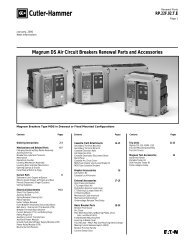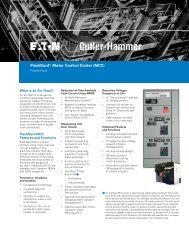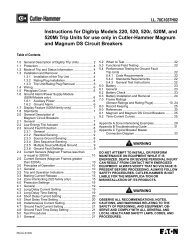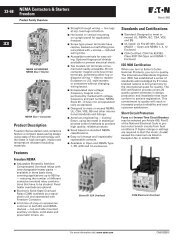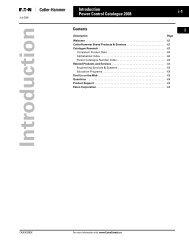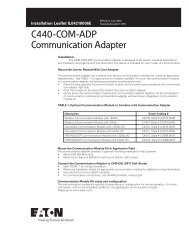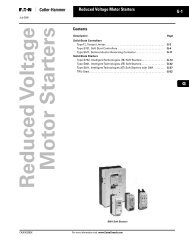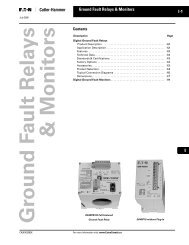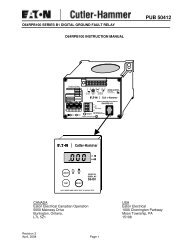M-Maxâ„¢ Series Adjustable Frequency Drive - Eaton Corporation
M-Maxâ„¢ Series Adjustable Frequency Drive - Eaton Corporation
M-Maxâ„¢ Series Adjustable Frequency Drive - Eaton Corporation
Create successful ePaper yourself
Turn your PDF publications into a flip-book with our unique Google optimized e-Paper software.
Serial Interface (Modbus RTU)<br />
Structure of the Master Request<br />
Address:<br />
● The address (1 to 255) of the frequency inverter to be sent<br />
the request is entered in parameter S2.3. Only the<br />
frequency inverter with this address can respond to the<br />
request<br />
● Address 0 is used as a so-called Broadcast (message to all<br />
slaves) from the master. In this mode, individual slaves<br />
cannot be addressed and data cannot be output from the<br />
slaves<br />
Data<br />
The length of the data block (Data: N x 1 Byte) depends on<br />
the function code. This consists of two hexadecimal<br />
character sets between 00 and FF. The data block contains<br />
additional information for the slave in order to carry out the<br />
operation defined by the master in the function code.<br />
Example: number of parameters to be processed.<br />
CRC<br />
The telegrams in the Modbus RTU have a CRC (Cyclical<br />
Redundancy Check). This CRC field consists of two bytes<br />
that contain a binary 16 bit value. The CRC check is always<br />
run independently of the parity check for the individual<br />
characters of the telegram. The CRC result is attached to the<br />
end of the telegram by the master. The slave recalculates<br />
while receiving the telegram and compares the calculated<br />
value with the actual value in the CRC field. If both values are<br />
not identical, an error is set.<br />
Structure of the Slave Response<br />
Required Transfer Time<br />
● The time between receiving a request from the master<br />
and the response of the frequency inverter is at least<br />
3.5 characters (rest time)<br />
● Once the master has received a response from the<br />
frequency inverter, it must wait for at least the rest time<br />
before it can send a new request<br />
132 M-Max <strong>Series</strong> <strong>Adjustable</strong> <strong>Frequency</strong> <strong>Drive</strong> MN04020003E—April 2011 www.eaton.com<br />
Function Code:<br />
The function code defines the type of message. The<br />
following operations can be executed on the M-Max:<br />
Function Code<br />
(hex) Designation Description<br />
03 Read Holding Registers Reading of the holding registers in the slave (process data, parameters, configuration)<br />
A master request enables up to 11 registers to be read<br />
04 Read Input Registers Reading of the input registers in the slave (process data, parameters, configuration)<br />
A master request enables up to 11 registers to be read<br />
06 Write Single Register Writing of a holding register in the slave<br />
With a general telegram (Broadcast) the appropriate holding registers are written in all slaves<br />
The register is read back for comparison<br />
10 Write Multiple Register Writing of several holding registers in the slave<br />
With a general telegram (Broadcast) the appropriate holding registers are written in all slaves<br />
A master request enables up to 11 registers to be read<br />
Normal Slave Response<br />
● If the master request contains a write register function<br />
(function code 06 or 16), the frequency inverter<br />
immediately returns the request as a response<br />
● If the master request contains a read register function<br />
(function code 03 or 04), the frequency inverter returns the<br />
read data with the slave address and the function code as<br />
a response<br />
Slave Response in the Event of an Error<br />
If a request contains an error (for example, incorrect data<br />
address or incorrect data value) other than a transfer error,<br />
the frequency inverter returns an exception message without<br />
executing anything. You can evaluate the exception message




